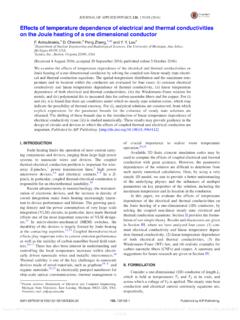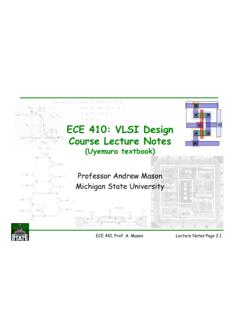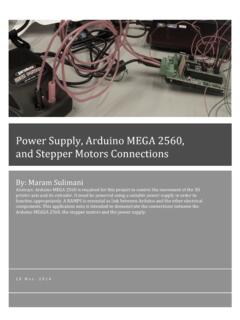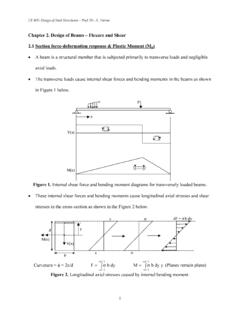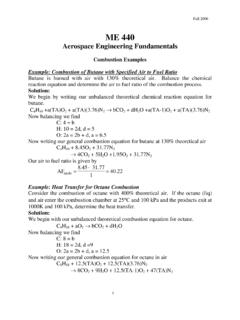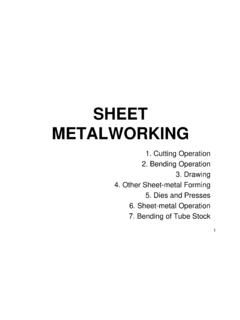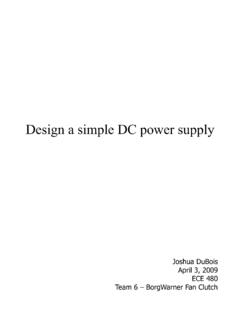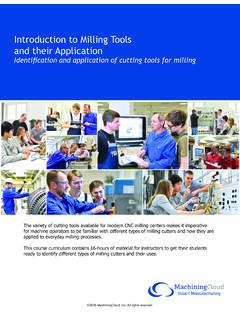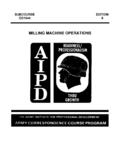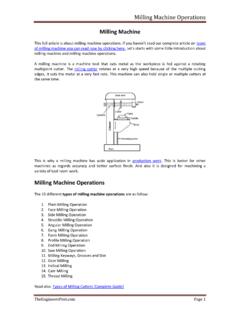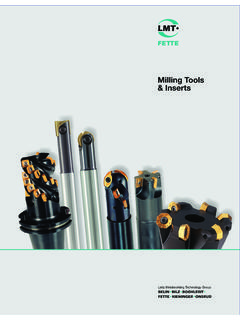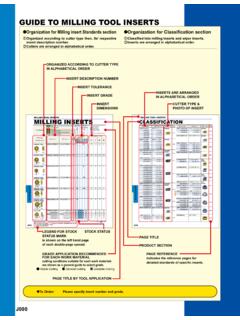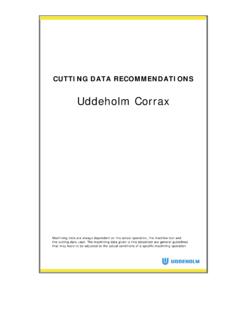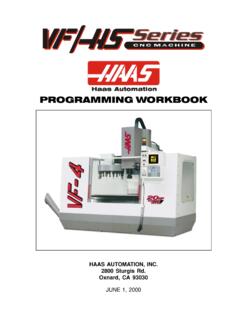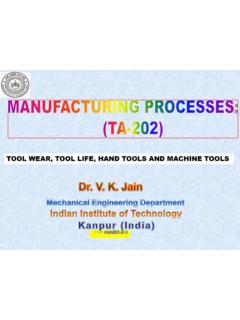Transcription of CUTTING TOOL TECHNOLOGY
1 1 CUTTING tool TECHNOLOGY1. tool life2. tool Materials3. tool Geometry4. CUTTING fluids2 Introduction Machining is accomplished by CUTTING tools. CUTTING tools undergo high force and temperature and temperature gradient. tool life Two aspects of design tool Materials tool Geometry CUTTING fluids31. tool life Three modes of failure Premature Failure Fracture failure - CUTTING force becomes excessive and/or dynamic, leading to brittle fracture Thermal failure - CUTTING temperature is too high for the tool material Gradual Wear Gradual failure tool wear: Gradual failure Flank wear -flank (side of tool ) Crater wear -top rake face Notch wear Nose radius wear4 Crater and Flank WearISO Standard 3685-1977 (E) 5 Possible Wear Mechanisms Abrasion Flank and Crater wear Hard Inclusions abrading CUTTING tools Hot Hardness Ratio Erosion Attrition Adhesion Compatibility chart Diffusion/Dissolution Crater wear Chemical solubility Diamond dissolves into iron.
2 Oxide coating resists crater wear. Plastic deformationAttrition Wear (from Tlusty, 2000)6 tool life tool life the length of CUTTING time that the tool can be used Break-in period Steady-state wear region Failure regionTimeFlank s Equation F. W. Taylor [1900] s Equation Generalized Taylor s Equation where v = CUTTING speed; T= tool life; and nand Cdepend on feed, depth of cut, work material and, tooling material nis the slope of the plot Cis the intercept on the speed axisCvTn=CdfvTpmn= tool materialnC (m/min)C (ft/min)High speed steel:Non-steel work carbideNon-steel work ,0008 tool Life Criteria in failure of CUTTING edge inspection of flank wear (or crater wear) by the machine test across CUTTING in sound emitted from become ribbony, stringy, and difficult to dispose of surface CUTTING time92.
3 tool Materials Important properties Toughness avoid fracture Hot hardness resist abrasion Wear resistance - solubility CUTTING tool materials Plain carbon and low alloy steels High-speed steels Cemented carbides, cermets and coated carbides Ceramics Synthetic diamond and CBN10 tool Materials Plain Carbon and Low Alloy Steels Before High Speed Steels Due to a high carbon content, heat treated to Rc=60 Poor hot hardness High-speed steels (HSSs) tungsten type (T-grade) 12-20% of W molybdenum type (M-grade)- 6% W and 5% Mo Other elements: Tungsten and/or Molybdenum, Chromium and Vanadium, Carbon, Cobalt in some grades Typical composition: Grade T1: 18% W, 4% Cr, 1% V, and C11 tool Materials HSSs Still used extensively for complex geometry such as drills Heat treated to Rc=65 Re-grinded for reuse Thin coating Cast Cobalt Alloys 40-50% Co, 25-35% W, 15-20% others Casting in a graphite mold and grind Toughness is not as good as HSS but hot hardness is better.
4 Not so important12 Cemented Carbides Advantages (Cemented Carbide, Cermets & Coated Carbides) High compressive strength and modulus High room and hot hardness Good wear resistance High thermal conductivity Lower in toughness that HSSs Grades Nonsteels grade WC-Co Steel grades add TiC and TaC due to the high solubility of WC into steels resulting in extensive crater wear Cemented Carbides Mainly WC-Co As grain size is increased, hardness decreases but TRS increases. As the content of cobalt increase, TRS increases but hardness decreases. For roughing or milling , high cobalt is desirable For finishing, low cobalt is of C-grade carbidesC1 RoughingC5C2 General purposeC6C3 FinishingC7C4 Precision Finishing C8 ToughnessWear ResistanceWith TiC and TaCSteel- CUTTING gradesNonsteel- CUTTING gradesAbrasive wear resistanceCrater wear resistanceCobalt contentTiC content14 Cermets Cermets TiC, TiN and TiCN with Ni or Mo as binders Applications: High speed finishing and semifinishing of steels, stainless steels and cast iron Higher speeds than carbides For better finish, low feed15 Coated carbides Since 1970, they improve machinability.
5 One or more layer of thinlayers of wear resistance CVD or PVD coating such as TiC, TiN, Al2O3, ZrN, CrC or Diamond. Coating thickness = - 13 m ( to in) Applications: cast irons and steels in turning and milling operations Best applied at high speeds where dynamic force and thermal shock are minimal 16 Ceramics, Synthetic diamond and CBN Ceramics Fine alumina powder is pressed and sintered at High pressure and temperature. Other oxide such ZrO2are added. Used in finishing of harden steels, high v, low d and f and rigid work setup. Not for heavy interrupted CUTTING Other ceramic tools: Si3N4, sialon(Si3N4-Al2O3), Alumina and TiC and SiC whiskers-reinforced alumina.
6 Diamond the hardest material. Usually applied as coating ( mm thick) on WC-Co insert Sintered polycrystalline diamond Applications: high speed CUTTING of nonferrous metals Cubic Boron Nitrides (CBN) For steels and Nickel alloys Expensive173. tool Geometry Single-point tool geometry Back rake angle ( b) Side rake angle ( s) End relief angle (ERA) Side relief angle (SRA) Side CUTTING edge angle (SCEA) Nose radius (NR) End CUTTING edge angle(ECEA)Nose radius(NR)ECEASCEAERA bSRA s18 CUTTING edge for a single-point tool19 tool geometry Chip Breakers For single-point tools, chip breaker forces the chip to curl so that it fractures Groove and obstruction types Effect of tool Material Positive rake angle -> reduce CUTTING force, temp.
7 And power consumption HSS: +5 < rake angle<+20 Carbides: -5 < rake angle <+10 Ceramics: -5 < rake angle <-15 The CUTTING edge: solid, brazed insert and clamped DrillsThe most common CUTTING tools for hole-makingUsually made of high speed steel21 Twist Drill Operation Rotation and feeding result in relative motion between CUTTING edges and workpiece CUTTING speed varies along CUTTING edges as a function of distance from axis of rotation Zero Relative velocity at drill point (no CUTTING ) A large thrust force to drive the drill forward Chip removal Flutes allow chips to be extracted Friction makes matters worse Rubbing between outside diameter and wall Delivery of CUTTING fluid to drill point22 milling Cutters Principal types.
8 Plain milling cutter Peripheral or slab milling (can be Helical) Form milling cutter -Peripheral milling cutter in which CUTTING edges have special profile to be imparted to work Important application -gear-making, in which the form milling cutter is shaped to cut the slots between adjacent gear teeth Face milling cutter End milling cutter18-teeth Plain milling CutterUsed for Peripheral or Slab MillingFour-tooth Face milling Cutter23 End milling cutter Looks like a drill bit but designed for primary CUTTING with its peripheral teeth Applications: Face milling Profile milling and pocketing CUTTING slots Engraving Surface contouring Die sinking 24 milling CutterFrom Schey [2000]25 Broaches and Saw BladesFinishing teethSemifinishingteethRoughing teethSaw Blade (Straight & Undercut toothor Straight & Raker sets)264.
9 CUTTING fluids Reduces heat generation at shear zone and friction zone (coolants) High specific heat and thermal conductivity (water-based coolants) Effective at high CUTTING speeds Reduces friction between tool and chip (lubricants) Effective at low CUTTING speeds Oil-based lubricants Low friction means low friction angle, which means shear angle decreases, which reduces fluids Chemical formulation CUTTING oils Emulsified oils Chemical fluids Application Methods Flooding Mist Manual Filtration Dry machining for Green ManufacturingCoolant effectincreasesLubrication effectincreases

